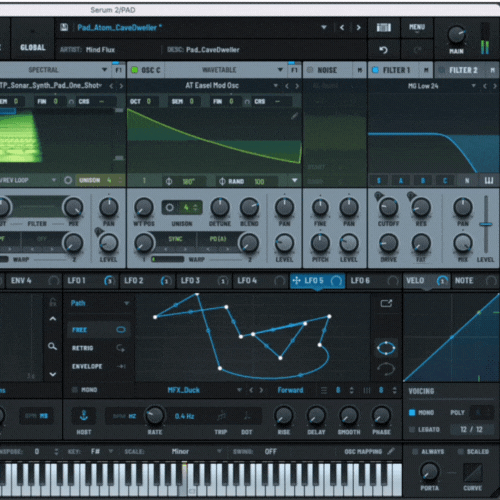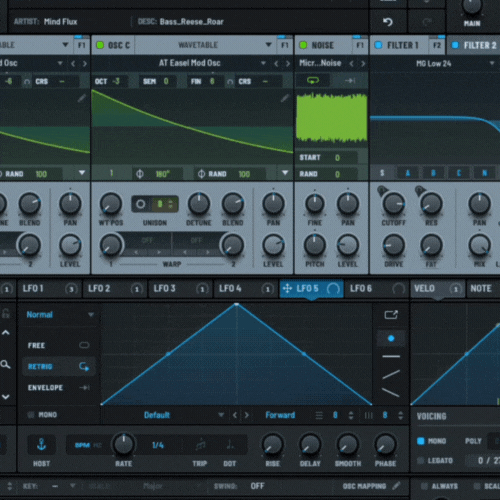Using Serum 2’s LFO Path Mode: Building Evolving Modulation for Techno
Serum 2 takes modulation to another level — introducing new LFO Path modes, Chaos sources, and expanded modulation routing.
For techno producers, these updates open up a deeper way to shape motion and texture directly inside the synth — giving your sounds the evolving energy that analog gear naturally has.
What’s New in Serum 2’s LFO System
In the original Serum, LFOs were already powerful — you could draw custom shapes, sync to tempo, and assign modulation anywhere.
Serum 2 builds on this with a new Path LFO mode that lets you design dual-axis modulation and expanded routing relationships between modulation sources.
Rather than creating a fixed looping curve, you can now build two-dimensional motion (using X and Y paths) that interacts dynamically with other parameters.
This means your LFO can follow a curve that isn’t just amplitude over time, but movement through space — opening more organic and rhythmic possibilities.
“It’s modulation that feels alive — less like automation, more like performance.”
Understanding Path LFO Mode
Path Mode turns an LFO into a movement generator.
Instead of a standard shape running left-to-right, the Path traces a continuous XY route.
Each axis can be sent to separate modulation destinations — for example,
X → filter cutoff
Y → oscillator warp
This allows you to sculpt complex inter-dependent movement without needing two LFOs or drawn automation.
Example setup:
Assign the X-axis of LFO 1 to filter cutoff for a sweeping motion.
Assign the Y-axis to distortion drive or wavetable position.
Set both to run at different speeds or retrigger points for shifting, syncopated movement.
The result: a sound that constantly evolves — never looping exactly the same way twice.
Why It’s Powerful for Techno
Techno thrives on repetition with variation — loops that breathe.
With Path Mode, you can design modulation that subtly mutates each bar, bar-group, or phrase.
The combination of curved trajectories and parameter cross-talk creates tension, release, and texture.
Try using Path LFOs for:
Evolving filter and distortion sweeps over long transitions.
Shifting stereo or pan motion to make pads or noise layers feel alive.
Interlinked parameter drift, where one motion slowly affects the next — ideal for hypnotic sequences.
“Path LFOs make your modulation feel human — constantly in motion but never chaotic.”
How to Use Path LFO Mode in Serum 2
Path Mode in Serum 2 works like drawing a modulation journey rather than a simple loop. You’re not just setting a rate and depth — you’re sketching motion across two dimensions, defining how parameters interact over time. Once you understand how to shape the path and assign its axes, you can build modulation that moves with intention and syncs perfectly to your track’s rhythm.
Select an LFO and change its mode to Path.
Draw your movement path — straight lines for mechanical motion, or curves for fluid motion.
Assign X and Y outputs to different parameters (for example, filter and resonance).
Experiment with rate and smoothing to match your track’s tempo and energy.
Layer Chaos modulation for subtle unpredictability.
Creative Ideas
Once you understand how Path LFOs work, the real power comes from how you combine the X and Y axes to drive different aspects of your sound.
Each path can become a performance in itself — rhythmic, evolving, or textural — depending on how you map it.
Here are a few ways to turn Path LFOs into expressive modulation systems tailored for techno producti
Dual-Axis Groove:
Use Path X to control filter cutoff rhythmically, and Y to add modulation to the delay time — syncing both to 1/8 and 1/16 notes for interplay.Organic Bass Movement:
Assign Path X to wavetable position and Y to oscillator fine tune. Add slight smoothing for pitch-like wobble that feels analog.Atmospheric Shimmer:
Route Path Y to reverb size and Path X to reverb mix, then add a slow Chaos LFO to modulate both — perfect for ambient techno transitions.
Wrap-Up
Serum 2’s Path LFOs bridge the gap between automation and performance.
By combining dual-axis motion, Chaos modulation, and expanded routing, you can design sound that evolves naturally — bringing movement, tension, and flow to every patch.
For techno production, it’s a way to build energy without adding layers — modulation becomes your arrangement.
“When movement tells the story, one synth voice can fill an entire mix.”



